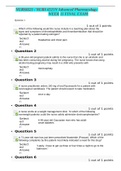Summary
Summary AQA Economics exam revision notes - entire course
- Module
- AQA A level economics
- Institution
- AQA
These are the revision notes I used to get an A* in Economics in the AQA exam. They are fairly concise, but all the content you need to answer almost any question is contained in them.
[Show more]












